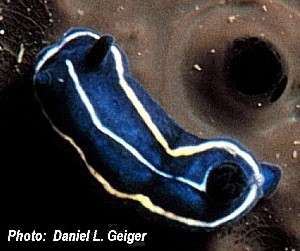
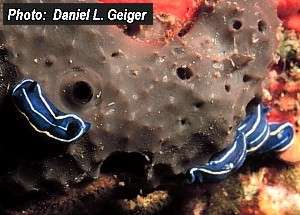
Hypselodoris orsinii
(Verany, 1846)
Order: NUDIBRANCHIA
Suborder: DORIDINA
Family: Chromodorididae
DISTRIBUTION
Known only from the western Mediterranean.
PHOTO
Feeding on sponge Scalarispongia scalaris. Bandol, Ile de Bendor, Mediterranean coast, France, 8-12m, 1990. PHOTOS: Daniel L. Geiger.
One of the many blue chromodorids from the Mediterranean and surrounding waters. The literature is very confused. The uniform blue gills and rhinophores, the submarginal white/yellow mantle border, and the single median white line, are characteristic of this species. It feeds on Scalarispongia scalaris and possibly Cacospongia sp. See messages below for further discussion on this species and it misidentifications. Hypselodoris orsinii is often misidentified as H. tricolor or H. coelestis.
Note added Oct 2008: see message #21969 for comments on identification of sponges eaten by this species.
-
Ortea, J., Valdés, A. & and García-Gómez, J.C. (1996) Revisión de las especies atlánticas de la familia Chromodorididae (Mollusca: Nudibranchia) de grupo cromático azul. [Review of the Atlantic species of the family Chromodorididae (Mollusca: Nudibranchia) of the blue chromatic group.] Avicennia, 1996, Suppl. 1: 1-165.
Rudman, W.B., 1999 (June 5) Hypselodoris orsinii (Verany, 1846). [In] Sea Slug Forum. Australian Museum, Sydney. Available from http://www.seaslugforum.net/find/hypsorsi
Related messages
Re: Feeding in Hypselodoris orsinii
October 15, 2008
From: Dominique Horst
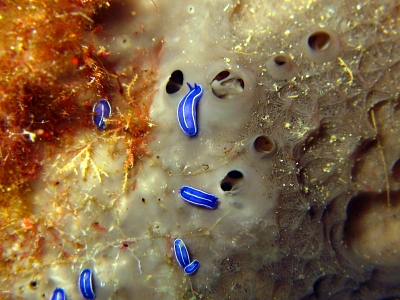
Concerning message #7384:
Hi Bill,
I've identified these blue chromodorids as Hypselodoris orsinii, and following Jean-Pierre Bielecki advice search for the tubercles, that are visible, with difficulties.
These animals are feeding, and I suppose that traces that are visible are left by their radula ....
Locality: Bagaud Island, 12 m, France, Mediterranean sea, 11 November 2008. Length: 4-5 mm. Photographer: Dominique Horst.
Kind regards,
Dom.
dominique.horst@wanadoo.fr
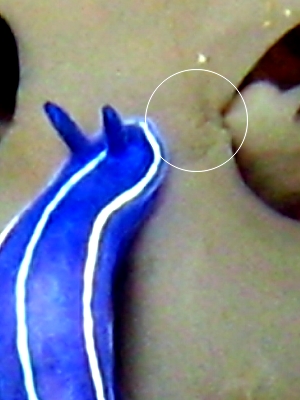
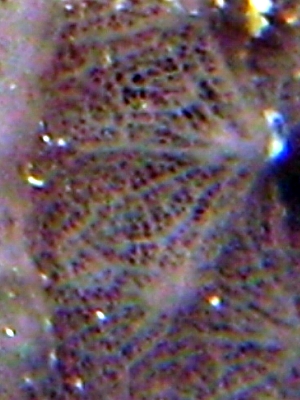
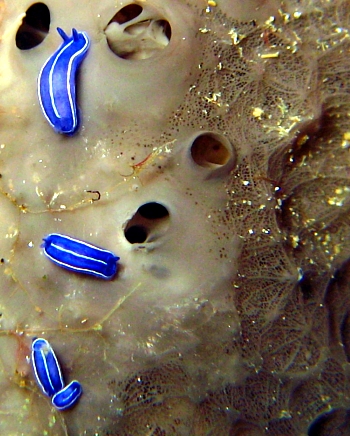
Dear Dom,
Thanks very much for these great photos. Yes this is Hypselodoris orsinii. One other way to identify it is from the sponge it is feeding on. Of the more than 40 species of Hypselodoris I have information on, all feed on sponges of the family Dysideidae except for two. One of these, H. bennetti, feeds on a species of Psammocinia (Fam: Irciniidae), and the other, H. orsinii, feeds on sponges of the Family Thorectidae. At present the literature suggests it feeds on both Cacospongia mollior and Scalarispongia scalaris, but as all the photos on the Forum [#7384, #11147, #7305, Fact Sheet] have been identified as Scalarispongia by Dr Bergquist, who is the world expert on the family, it makes me wonder if the literature records for Cacospongia mollior are misidentifications, as the two species are difficult to separate externally, and Scalarispongia scalaris was previously considered a species of Cacospongia.
I have not shown your photos to Dr Bergquist but I am pretty sure the sponge is Scalarispongia scalaris. One of the features of the genus is the way the secondary bundles of fibres in its skeleton are arranged in a regular ladder-like structure, which we can see in the close-up I have included. Why H. orsinii is the only species of the genus to feed on a thorectid sponge rather than a dysideid, is a mystery, as their are other species of Hypselodoris in the Mediterranean and they find dysideid sponges living their quite palatable. Perhaps H. orsinii will turn out to be unrelated to other Mediterranean species of Hypselodoris or perhaps it is an adventurous species beginning a new branch of Hypselodorisevolution.
-
Cook, S. de C. & Bergquist, P.R. (2000) Two new genera and five new species of the "Cacospongia" group (Porifera, Demospongiae, Dictyoceratida). Zoosystema, 22(2): 383 - 400.
-
Cook, S. D. C. & Bergquist, P. R. (2002). Family Thorectidae Bergquist, 1978. pp. 1028-1050 [In] Hooper, J.N.A. & Soest, R.W.M. Van (eds) Systema Porifera. A guide to the classification of sponges. New York, Boston, Dordrecht, London, Moscow: Kluwer Academic/Plenum Publishers Vol. 1
-
Rudman, W.B. & Bergquist, P.R. (2007) A Review of feeding specificity in the sponge-feeding Chromodorididae (Nudibranchia: Mollusca). Molluscan Research, 27(2): 60-88
Best wishes,
Bill Rudman
Re: Hypselodoris orsinii from Croatia
October 8, 2003
From: Adam Petrusek
Dear Bill,
Concerning your question - I am certain the sponge is Aplysina (at least of the genus) but I do not know how the slug got there. There have been several divers around...
Adam
petrusek@cesnet.cz
Petrusek, A,, 2003 (Oct 8) Re: Hypselodoris orsinii from Croatia. [Message in] Sea Slug Forum. Australian Museum, Sydney. Available from http://www.seaslugforum.net/find/11171Thanks Adam
Bill Rudman
Hypselodoris orsinii from Croatia
October 7, 2003
From: Adam Petrusek
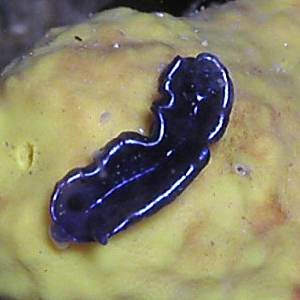
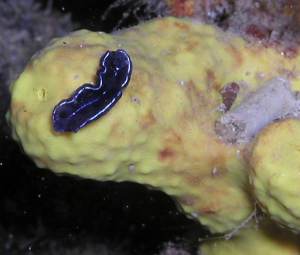
Dear Bill,
To accompany my earlier message here is another seaslug from the Adriatic Sea, taken at the unique locality Vrulja on Makarska Riviera, Croatia, on September 16, 2003.
Here is another Hypselodoris(?) on Aplysina cavernicola; depth ~15 m.
Thanks for the help.
Adam
petrusek@cesnet.cz
Petrusek, A,, 2003 (Oct 7) Hypselodoris orsinii from Croatia. [Message in] Sea Slug Forum. Australian Museum, Sydney. Available from http://www.seaslugforum.net/find/11147Dear Adam,
Like Hypseldoris tricolor in your accompanying message this is another of the 'blue hypselodorids'. I am pretty sure this is Hypselodoris orsinii. Juvenile H. tricolor can look quite like this as well so I can't be 100% sure.
Are you sure of the sponge identification? Ortea et al (1996) report that it feeds on sponges of the genus Cacospongia.
• Ortea, J., Valdés, A. & and García-Gómez, J.C. (1996) Revisión de las especies atlánticas de la familia Chromodorididae (Mollusca: Nudibranchia) de grupo cromático azul. [Review of the Atlantic species of the family Chromodorididae (Mollusca: Nudibranchia) of the blue chromatic group.] Avicennia, 1996, Suppl. 1: 1-165.
Best wishes
Bill Rudman
Hypselodoris coelestis from the Mediterranean
March 18, 2003
From: Nicolas
Dear Bill,
I found in a book (To discover the Mediterranean Sea by Steven Weinberg) a species of dorid named in the book Hypselodoris coelestis. This species is said to be endemic to the Mediterranean but I can't find information on it anywhere. Could you tell me if you know anything about it. The book calls it "Doris celeste" in French and "Celestial doris" in English.
Thank you
Nicolas,
Paris
ndiver@voila.fr
Dear Nicolas,
The correct name for Hypselodoris coelestis is Hypselodoris orsinii. If you look at the messages in the Forum about this species you will see that in France several guides to the Mediterranean fauna call Hypselodoris orsinii either H. tricolor, which is another species, or H. coelestis which isn't a valid name. As you will see there are quite a few blue chromodorids in the Mediterranean with very similar colour patterns.
Best wishes,
Bill Rudman
How to recognise Hypselodoris orsinii
June 29, 2002
From: Jean-Pierre Bielecki
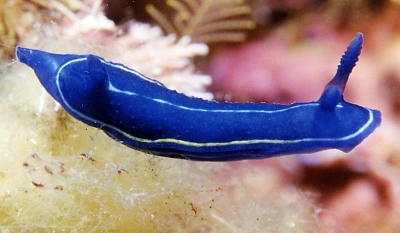
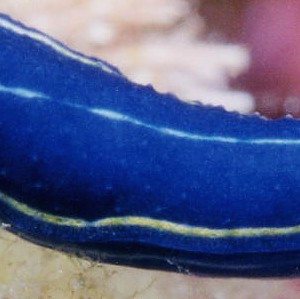
Hi Bill,
Hypselodoris orsinii is a very common species in the south of France [Mediterranean] and among the similar blue chromodorids, there is a very sure way to identify it. There are small blue tubercles on the notum, sometimes only visible with a magnifying glass, but always present.
Size: 1cm
depth: 20m
South of France, Cannes in May 1999
Regards,
Jean-Pierre
bielecki.jeanpierre@free.fr
Bielecki Jean-Pierre, 2002 (Jun 29) How to recognise Hypselodoris orsinii. [Message in] Sea Slug Forum. Australian Museum, Sydney. Available from http://www.seaslugforum.net/find/7383Thanks Jean-Pierre,
Bill Rudman
Feeding in Hypselodoris orsinii
June 29, 2002
From: Jean-Pierre Bielecki

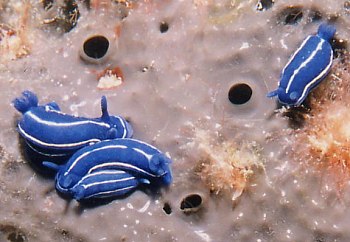
Hi Bill,
Here is a photo of
Hypselodoris orsinii on its food sponge Cacospongia sp. is a very common specie in south of France in mediterranean and among the similar blue chromodorids, there is a way very sure to identify it, is to see the small blue tubercles on the notum, sometimes only seeing with a magnifying glass, but always present.
Size: 1cm
depth: 20m
Cannes, Mediterranean coast of France, May 1999
Regards,
Jean-Pierre Bielecki.
bielecki.jeanpierre@free.fr
Bielecki Jean-Pierre, 2002 (Jun 29) Feeding in Hypselodoris orsinii. [Message in] Sea Slug Forum. Australian Museum, Sydney. Available from http://www.seaslugforum.net/find/7384Dear Jean-Pierre,
Thanks for this photo. You can clearly see the feeding scars on the sponge and in the closeup photo [lower] you can see that the upper animal on the left has its oral tube everted onto the sponge - a sure sign of feeding.
Best wishes,
Bill Rudman
Re: Hyps. orsinii from French Mediterranean
June 26, 2002
From: Marina Poddubetskaia
Hi Alma,
Thank you for your confirmation of this ID. In France several guides of Mediterranean fauna call Hypselodoris orsinii H. tricolor or H. coelestis (which isn't a valid name). So, divers are embarrassed with this identification. If you see the message of Christian Desprez (May 27, 1999), I'm sure he speaks in fact about H. orsinii. I think, it's really the most common nudibranch in French Mediterranean, especially in May - June. Last year, I saw them at all sites I dived, near Toulon and in Corsica near Sagone. In September they completely disappeared. And no, I saw large numbers of them near Marseille. The real H. tricolor is rarer here.
Best wishes,
Marina.
nembro@nembro.info
Poddubetskaia, M. , 2002 (Jun 26) Re: Hyps. orsinii from French Mediterranean. [Message in] Sea Slug Forum. Australian Museum, Sydney. Available from http://www.seaslugforum.net/find/7354Thanks Marina,
No one should get embarrassed about getting an identification wrong and especially when the blue chromodorids of the Mediterranean are concerned. The scientific literature is full of mistakes made by 'the experts'. When you have a group of animals which have evolved together to look like each other, we should be amazed by how well they have succeeded rather than be ashamed by how easily they can trick us.
What would be very useful would be to have photos of these species on their food sponges and laying eggs. Most have very specialised diets, eating only one or two related sponges, and most have very distinctive egg ribbons. While this information is available in the scientific literature - (although sometimes the information is confused because of misidentifications of the sponges and the nudibranchs)- photos would make it much more accessible to the general public.
Best wishes,
Bill Rudman
Re: Hypselodoris orsinii from French Mediterranean
June 25, 2002
From: Alma Sánchez
Dear Dr. Rudman and Marina,
Effectively, your ID is correct, this animal is Hypselodoris orsinii. I have found specimens in the Strait of Gibraltar and adjacent areas but It's not an abundant species as others cogenerics species as Hypselodoris tricolor, Hypselodoris bilineata and Hypselodoris picta.
Best wishes,
Alma
almasanchez83@hotmail.com
Sánchez, A., 2002 (Jun 25) Re: Hypselodoris orsinii from French Mediterranean. [Message in] Sea Slug Forum. Australian Museum, Sydney. Available from http://www.seaslugforum.net/find/7349Thanks Alma,
Bill Rudman
Hypselodoris orsinii from French Mediterranean
June 24, 2002
From: Marina Poddubetskaia
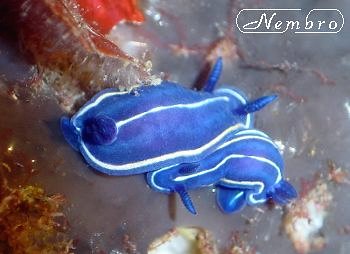
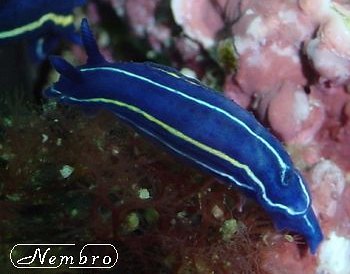
Dear Bill,
Could you confirm, please, the identification of this blue doris. I think it's Hypselodoris orsinii. During spring this nudibranch is very common and could be found everywhere in French Mediterranean.
• Upper:
Cap Croisette (near Marseille), France. Site : Passe de Maire. Depth: 12-15m, Size: about 1 cm. June 03, 2002.
• Lower:
Cap Croisette (near Marseille), France. Site: Pierre qui tramole. Depth: 16m. Size: about 1 cm. June 04, 2002.
Best wishes,
Marina.
nembro@nembro.info
Poddubetskaia, M., 2002 (Jun 24) Hypselodoris orsinii from French Mediterranean. [Message in] Sea Slug Forum. Australian Museum, Sydney. Available from http://www.seaslugforum.net/find/7305Dear Marina,
I am pretty sure the uniform blue gills and rhinophores, the submarginal white/yellow mantle border, and the single median white line, are characteristic of this species, but I will wait for confirmation from a local expert.
Best wishes,
Bill Rudman
Hypselodoris orsinii? from Turkey
September 28, 2001
From: Baki Yokes
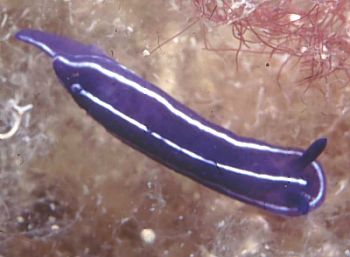
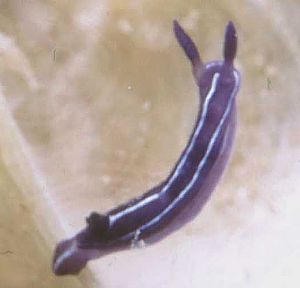
Dear Bill,
I'm not sure whether these photos belong to Hypselodoris tricolor or Hypselodoris orsinii (H. coelestis according to Societa Italiana di Malacologia). Although they lack the yellow margin, they match with the description given in the Atlas of Mediterranean Nudibranchs for H. tricolor pp.75), since the margin can be white as well according to the decription given. When compared to the blue chromodorid in my other message, these specimens are thinner and smaller, and never exceed 2 cm in size. They are very common in North Aegean Sea and can be seen at any depth, usually on black horny sponges Cacospongia sp.
Both photos were taken by me at Saros Bay Divesite, Canakkale, Turkey. Upper Photo: Depth: 12m; 2cm long; September 1999. Lower Photo: Depth: 8m; 1cm long; August 1999
Best wishes
Baki
bakiyokes@turk.net
Yokes, B., 2001 (Sep 28) Hypselodoris orsinii? from Turkey. [Message in] Sea Slug Forum. Australian Museum, Sydney. Available from http://www.seaslugforum.net/find/5339Dear Baki,
Thanks for these photos. I can understand your confusion with these 'blue chromodorids' which are still in the process of being sorted out. They represent a group of related species which have evolved to look very alike so that predators learn to leave this blue colour pattern alone. Predators avoid them because they store noxious chemicals in glands or sacs in their skin. Have a look at the Page on a group of red-spotted species in Australia which do the same thing.
So there are a number of problems to untangle. Firstly, we need to work out how many species there are and how to recognise them, preferably without having to dissect every individual to be sure! Secondly, we need to go through all the old literature and try and determine what all the old names for these species refer to. In some cases the descriptions consist of 2 or 3 lines of text saying little more than 'blue with yellow lines'. And thirdly we then need to try and untangle all the subsequent identifications and misidentifications of the names which have occurred in the last century.
Unfortunately many of the biological and ecological studies which have been published on these animals may be useless unless there is some way of checking and confirming the identifications of the animals they studied.
I am using the most recent revision of this group [Ortea, Valdés & García-Gómez, 1996 -see reference at top of page] but even that may not be the final story. In that your animal is identified as Hypselodoris orsinii and Cacospongia sp. is its reported food sponge. It is possible you have more than 2 of these blue species in your area. Apart from keeping an eye open for strange colour patterns, one valuable contribution would be to see if you can find blue chromodorids on other sponges, and where possible see if you can photograph them laying eggs. A closeup of the egg ribbon might provide a very useful piece of information.
Best wishes,
Bill Rudman
